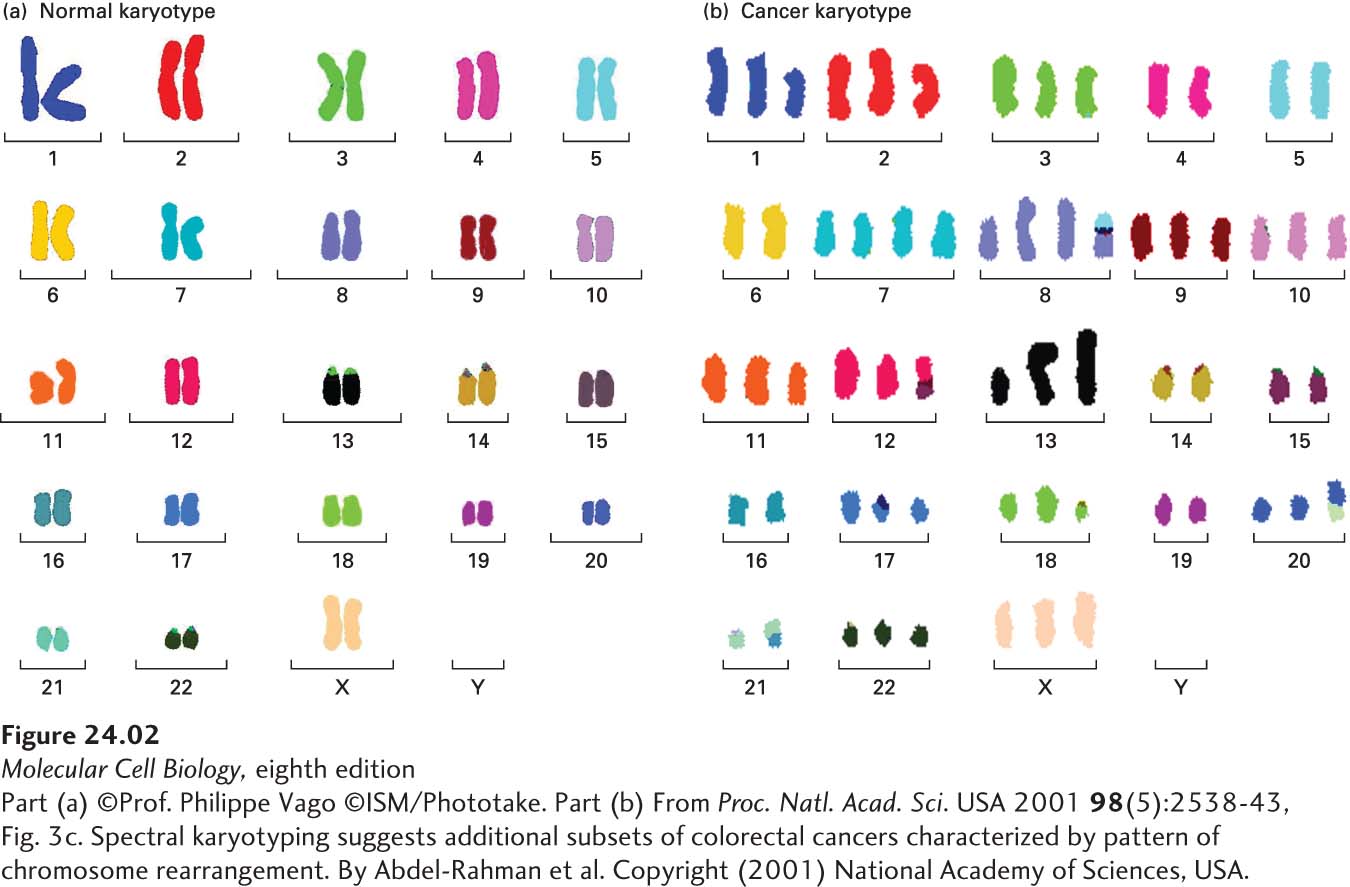The Genetic Makeup of Most Cancer Cells Is Dramatically Altered
At the turn of the twentieth century, David von Hansemann and Theodor Boveri first documented what we now know to be an almost universal feature of cancer cells: their entire genetic makeup differs dramatically from that of normal cells. Tumors harbor all types of genetic alterations—point mutations, small and large amplifications and deletions, translocations, and aberrant numbers of chromosomes—generally too many, a condition known as aneuploidy (Figure 24-2). The recent sequencing of many human tumors has provided insights into the frequency with which these genetic changes occur in specific cancers and has identified new types of mutational mechanisms. Typical cancer cells exhibit whole chromosome or chromosome arm gains and losses involving a quarter of their genome. Local amplifications and deletions affect about 10 percent of the cancer cell’s genome. Perhaps the most surprising result revealed by the sequencing of cancers is the high degree of variation in mutation rates across different cancers. Mutations are rare in pediatric cancers, with substitution rates as low as 0.1 base changes per megabase, but those rates may be as high as 100 base changes per megabase in mutagen-induced cancers such as lung cancer and melanoma.

FIGURE 24-2 Cancers have highly abnormal karyotypes. Image of chromosomes obtained (a) from a normal human cell, with its characteristic 23 pairs of chromosomes, and (b) from an SW403 colorectal adenocarcinoma cell line. Each individual pair of chromosomes has a distinctive color. Two characteristics of the cancer cells are evident. First, the number of individual chromosomes is altered compared with normal cells. Second, many chromosomes are composites of pieces from different chromosomes.
[Part (a) ©Prof. Philippe Vago ©ISM/Phototake. Part (b) From Proc. Natl. Acad. Sci. USA 2001 98(5):2538-43, Fig. 3c. Spectral karyotyping suggests additional subsets of colorectal cancers characterized by pattern of chromosome rearrangement. By Abdel-Rahman et al. Copyright (2001) National Academy of Sciences, USA.]
DNA replication and chromosome segregation errors can lead to aneuploidy and to gains and losses of chromosome arms. Decreased replication fidelity and mutagens also profoundly affect the cancer genome. In addition to these well-established genome instability–inducing mechanisms, cancer genome sequencing has identified other novel, unusual mechanisms that lead to the dramatic genomic changes observed in human cancers. Hypermutation characterized by multiple base-pair substitutions near translocation break points has been discovered. The mechanism underlying this dramatic local genome alteration, termed kataegis (from the Greek for “thunderstorm”), is not known, but probably involves an enzyme, known as activation-induced deaminase (AID), that plays a key role in antibody diversity generation, which is discussed in Chapter 23. Another highly unusual mutational mechanism that occurs in 2–3 percent of human cancers, but with a prevalence of up to 18 percent in aggressive neuroblastomas (a type of nerve cell tumor), is called chromothripsis. Here entire chromosomes or large parts thereof are shattered (thripsis in Greek means “shattering”) and stitched together again in what appears to be a random manner, leading to dozens or sometimes even hundreds of rearrangements. This shattering and stitching together of individual chromosomes appears to occur when chromosomes or parts thereof are not incorporated into the nucleus, but rather form their own micronuclei. There replication occurs less efficiently, leading to chromosome breakage and stitching together of chromosome pieces in a random manner by nonhomologous end joining, a form of DNA repair in which DNA pieces are fused together via their ends. As we will see in the following sections, the genetic changes that occur in cancer cells affect virtually all aspects of cellular homeostasis, proliferation, tissue organization, and migratory properties as well as survival and proliferation at foreign sites in the body.
